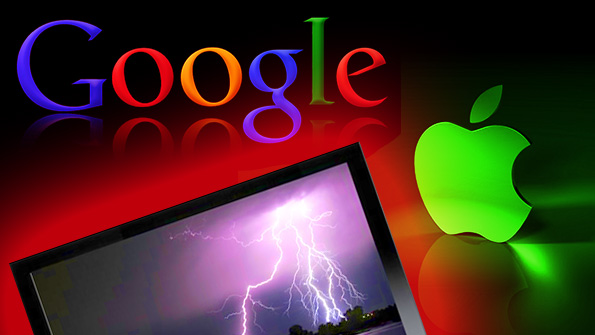Google vs. Apple - The Race to Push Video to Your TV

The link from your mobile tablet to your living room TV is about to get even stronger. Recently Google announced that Android phones and tablets could push out YouTube video to Google TV devices, much the same way iPad and iPhones can send video to Apple TV via AirPlay. Google has had great response to the new functionality and now intends to take it a bigger step forward, although Apple is brewing some moves of its own.
Google is aligning with TV manufacturers such as Sony, LG, Panasonic and Bang & Olufsen to incorporate special circuitry built into TVs so it can receive the YouTube streams with no additional hardware needed. Google also intends to roll this out to more hardware from Samsung, Phillips, Sharp, Toshiba, Western Digital and Vizio in the coming months. The new move has a lot of distinct advantages. First, concerning the TVs, there is one less SmartTV app to configure — it is certainly easier to just send content to a TV, as opposed to setting up a TV-based app. Consumers are already used to viewing content on their tablet, so sending it to the big screen in one click should be an easy task. Pertaining to Android, if Google can roll this out to more seats on tablets and build the technology into more TVs and hardware video devices, it has a chance to capture a large demographic that their Google TV set-top devices may be missing due to lukewarm response.
Clearly inspired by Apple’s AirPlay and Apple TV, there are distinct differences on the Apple side of this kind of tech. There are numerous variances of Android OS flavors but Apple’s iOS has AirPlay built in to the OS. If and when Apple does decide to make its own TV, millions of devices, iPhones to iPads to iPods, would immediately be compatible. The Apple TV device is already gaining a lot of traction, and last year it sold more units than ever. Apple also lets users send the entire OS screen to the Apple TV, not just the YouTube app, so there is much more flexibility with gaming and other apps. Not all apps have AirPlay built in, but more are adding it, such as HBO announcing this week that HBOGo now can stream to Apple TV via AirPlay.
Where is all this heading? Likely in a couple of directions. Initially Smart TVs came with apps that were just not very smart. Or speedy. Anyone who uses an app built into a TV knows all too well that without a dedicated processor or advanced OS, using a TV app is often a slow and cumbersome process, with minimal updates and a wide variety of different interfaces to figure out. The term Android-powered TV was thrown around and then likely thrown out, as Google focuses on a set-top box via partners such as Sony and Logitech. Logitech gave up on Google TV, but Sony keeps chugging along with a new model this year. But it has yet to set the world on fire. The better path may be to have people use the interface they already know, on their Android mobile device, and just send content to the TV when they need it. No doubt this will advance and it would not be surprising that Google TV makes the transition from hardware box to Google Play app. This does leave the market open to be captured by companies such as Roku, but the barrier to acceptance is significantly reduced. Instead of buying a Google TV device, just use a Google TV app on the Android device you already own.
Apple works in stealth mode and it's harder to see its cards, but it would surprise no one to see an Apple TV set this year. Whether it will have an app ecosystem built into the TV, or have the iPad become the controller and apps work via AirPlay, is anyone’s guess. One thing is for sure, if Apple does advance its Apple TV box and/or new Apple TV set to include a developer-friendly ecosystem where apps can be downloaded for free and purchased, including games, programs and channels, it could reinvent the TV industry much the same way it reinvented (or invented) the Smartphone industry back in 2007 with the launch of the original iPhone.
Whatever happens, it is a pivotal year for both companies, and at the end of the year we’ll have a better view of the scope of things. Even as platforms such as Microsoft's Xbox 360/Xbox 720 and Sony’s PS3/PS4 blossom, and Dyle-branded mobile TV devices slowly launch, Google and Apple have the most to lose — and gain — by dominating the living room. Google has tried to enter the living room with minimal success, and pushing video from Android tablets could be the hook it needs. Apple is already in the living room, and in people's mobile lives via its best-selling tablet and phone, so extending that brand to an actual branded TV would close a gap and produce an even larger device halo effect than the company already has. Add an app ecosystem into the mix, and there is huge potential.
The race to get video to your mobile device has already happened, the next race is for your bigger screen. Both companies have the infrastructure and resources to make it happen, and it may be less a case of who gets there first, but rather who does it best.
The professional video industry's #1 source for news, trends and product and tech information. Sign up below.
